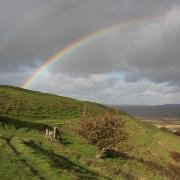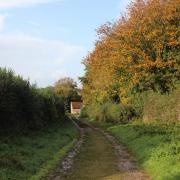Whether you love piers, promenades and fish and chips, or cliff top views and sea swimming, we all have a stretch of the British coast that is close to our heart. This year the Ramblers is on a mission to complete England’s coastal path, and they want to encourage everyone to discover it.
‘The King Charles III England Coast Path won’t just allow walkers to explore everything our coastline has to offer; it will also transform the way we enjoy it, giving us the freedom to explore the clifftops and beaches that surround the path,’ says Rebecca Birrane, head of walking experience at the Ramblers, Britain’s walking charity which has around 500 walking groups across the country.
The England Coast Path has five regional sections: North West - from the Scottish Border at Gretna Green to the Welsh Border near Chester; North East - from the Scottish Border above Berwick down to the Wash; East - the Wash to the Thames Estuary; South East - Thames Estuary to Bournemouth; South West - from the Welsh Border at Chepstow to Bournemouth. This will also link the South West Coast Path, running from Minehead in Somerset to South Haven Point in Dorset, to the new national walking path. So, if those 630 miles aren’t enough of a challenge, there will be another 2,000 miles to enjoy.
‘A brisk sea breeze can be exhilarating, while gazing out at the ocean can calm the mind like nothing else,’ adds Rebecca. ‘We want everyone to be able to enjoy that, which is why we’re so excited about the England Coast Path. It gives access to more amazing seaside places for us to walk, making it easier for people to experience the joys of coastal walking.’
Once complete the England Coast Path, renamed the King Charles III England Coast Path in 2023 to celebrate the King’s coronation, will be the longest continuous managed coastal trail in the world. This 2,700-mile path will offer a huge range of connecting routes.

However, the creation of the country’s most ambitious national trail required decades of campaigning, planning and work. ‘We first launched our campaign for the England Coast Path in 2004 with the goal of transforming how we can access our coastline,’ says Rebecca. ‘But it wasn’t until 2010 that work began. Teams of dedicated Ramblers Coastal Access Volunteers have been working hand in hand with Natural England to plan, map and build the best route, walking, surveying and mapping every stretch of the path.’
The walking charity has been tracking its progress through their Coast Path Countdown as, mile by mile, work continues to connect the remaining stretches of the trail. This summer they are calling on people across the UK to make the most of the coast and get out there to explore it on this new trail. There is also a secondary benefit too.
‘Spending time by the sea can also be invaluable for our mental health,’ Rebecca explains. ‘The wellbeing benefits of spending time outdoors are well known, but studies have shown that these positive effects are even greater when we’re by the sea.’
As well as boosting levels of vitamin D, improving mood and reducing anxiety, when a study from London School of Economics and the University of Sussex asked participants to rate their mood in different locations, marine and coastal areas were found to be some of the happiest.
A survey by the National Trust discovered that fresh coastal air could have significant sleep benefits, with coastal walkers in the UK sleeping 47 minutes longer after a ramble by the sea. And nearly two-thirds of participants said that a coastal walk allowed them a distraction from the stresses of everyday life with over half reporting feeling more positive.

In Blue Spaces: How and why water can make you feel better, Dr Catherine Kelly (University of Brighton) explores the importance of blue space (water environments) and its therapeutic benefits. ‘Research shows us that blue spaces are humans' preferred locations for walking besides,’ says Dr Kelly. ‘As well as the expected positive effects of exercise itself, walking by the sea engages most of our senses, which brings additional wellbeing benefits. Looking at the sea, listening to the sound of it, smelling the salty air, all allow our breathing to slow down, and stress hormones to reduce. Being by the sea also often induces feelings of gratitude and joy and offers effortless mindfulness - pleasure from being in the moment, where we can forget about our worries.'
The best part? You don’t need a sea view to experience the benefits. Researchers from the University of Exeter found you’ll start to feel the benefits after just two hours a week by the seaside. According to Dr Lewis Elliot, 271 million leisure visits are made to coastal environments in England each year. ‘The coast has long been used as an environment for holidays, convalescence, and physical activity. Our research has found multiple studies indicating that these environments hold significant benefits for supporting physical activity, increasing social contact, reducing stress, improving mental health, and potentially reducing health inequalities. Even short walks by the coast can improve psychological health.’
From beautiful beaches, wildlife hotspots, cycling trails and coastal walks to kitesurfing, beachcombing and stargazing, England’s coastline offers some of the best stress busters, whatever the weather. And that includes Dorset’s stunning coastline.
For summer walking tips, inspiration and routes, including a free to download summer walking guide, go to ramblers.org.uk

Pack a picnic and your swimming togs for this coastal ramble with breath-taking views far from the packed beaches of summer. This circular walk showcases the wild, rugged windswept beauty of the Isle of Portland. It takes you to the remains of Rufus Castle, a ‘Bow and Arrow Castle’ whose thick walls are dotted with holes for archers to shoot from. Take a detour from here to the ruins of St Andrew's Church to look for skull and crossbones carvings on the gravestones - an ancient symbol for death rather than pirates! Allow some time at the end of your walk to explore the 60 hidden sculptures in Tout Quarry, including Anthony Gormley’s work ‘Still Falling’. Find the full route with directions and map at ramblers.org.uk/portland
Start Point: New Ground Car Park (Grid Ref: SY690731)
Difficulty: Moderate Distance: 8.7 miles
Time: 4 1/2 hours



























